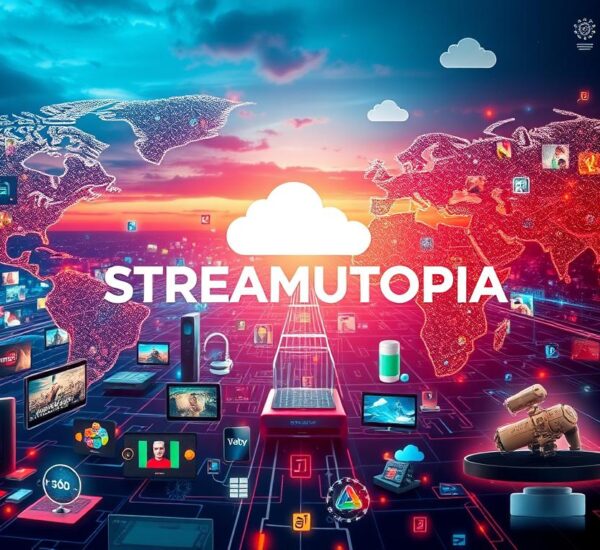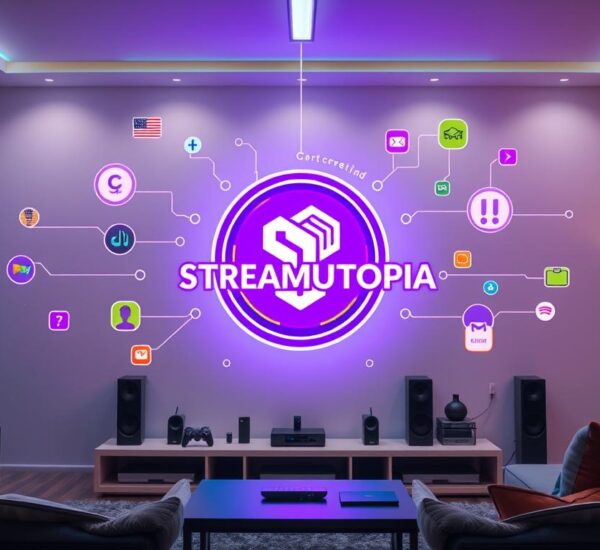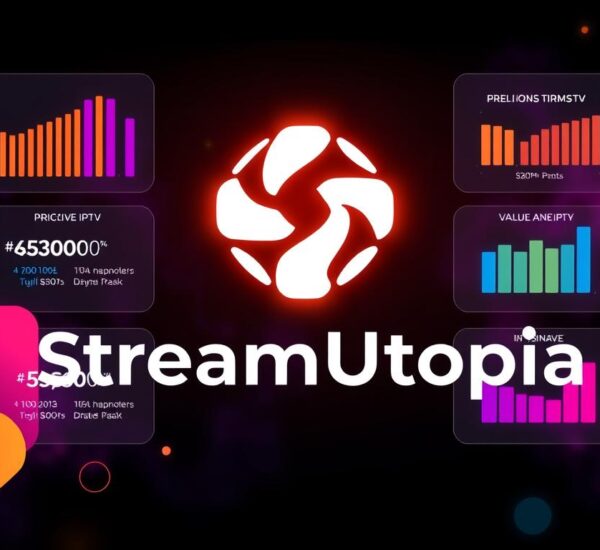Have you ever thought about why IPTV is becoming the top choice for viewers, leaving traditional TV behind?
IPTV is changing how we watch TV, becoming a top pick over cable and satellite TV. This change is because of its flexibility, cost savings, and new features. More people are choosing IPTV for its control over viewing and its growing popularity. Experts say the IPTV market will double by 20291. Also, IPTV is getting more popular worldwide, growing by 30% to 35% each year2.
In today’s world, we value convenience and personal choice. So, it’s no surprise that IPTV’s benefits are making people think: is it time to switch from traditional TV to IPTV? With its huge selection of on-demand content and the ability to watch on many devices, IPTV could be the best upgrade for your viewing habits.
Key Takeaways
- IPTV offers flexibility and convenience, allowing users to watch their favorite shows anytime, anywhere.
- The market value of IPTV is projected to double by 2029, highlighting its rapid growth.
- With over one billion subscribers globally, IPTV is becoming a household name.
- Sports content specifically is seeing a significant embrace within IPTV platforms, making it appealing for sports fans.
- Cost-effectiveness is a key advantage of IPTV, often providing more economical options compared to traditional TV packages.
Introduction to IPTV
Understanding IPTV is key to knowing how modern TV works. IPTV, or Internet Protocol Television, sends TV shows and videos over the internet, not through old-school broadcast methods3. It lets viewers pick what they want to watch, blending live TV with on-demand shows4.
This technology uses networks like DSL to manage videos. It gives operators control over how videos are sent, ensuring they work well and are reliable3. IPTV uses special protocols for live TV and on-demand shows, making it easy to watch lots of content when you want3.
Big names like Verizon, Netflix, and Hulu offer IPTV services3. Subscribers get to enjoy lots of channels and features on devices like smart TVs, tablets, and phones4.
Understanding Traditional TV and its Limitations
Traditional TV, mainly through cable and satellite, has big limitations. One big issue is the high cost of subscription fees. These fees can change a lot based on the channels and features you get. IPTV, on the other hand, lets you pick what you want to watch at a lower cost5.
This makes IPTV a better choice for many. It’s different from traditional TV, which has strict schedules and fewer choices6.
Traditional TV often doesn’t offer many channels for international or niche content. IPTV, however, gives you more channels and lets you watch shows on demand or catch up on missed episodes5. Many people also want to be able to pause or rewind live TV, which traditional TV doesn’t offer6.
Even with its perks, traditional cable is known for its good service and coverage of live sports. But, its high cost and limited options are pushing people to choose IPTV, especially where traditional services are poor5. Understanding these downsides of traditional TV helps explain why more are switching to IPTV.

Cost Savings with IPTV
IPTV offers big savings on entertainment costs. It has many subscription plans for different budgets. Services like Hulu TV, Sling TV, and YouTube TV cost between $25 and $65 a month. This is cheaper than traditional cable, which starts at $50 to $60 and can go over $100 for more features7.
Choosing IPTV helps avoid hidden cable costs like renting equipment, which adds $5 to $15 a month.
Affordable Subscription Plans Compared to Traditional TV
IPTV has clear pricing, showing the value of your subscription without surprise fees. Unlike cable, which can cost $50 to $200 to install, IPTV usually doesn’t need professional setup7. IPTV also lets you change plans monthly without extra fees, unlike cable’s long contracts with penalties.
Hidden Costs of Cable and Satellite Services
Cable often has hidden fees like broadcast and sports fees that can add $20 to your bill7. IPTV cuts these costs, giving you more content without extra charges. Over three years, choosing IPTV could save you about $2,410 compared to cable, considering subscription costs, equipment, and installation fees7.
IPTV offers big savings and affordable plans, making it a great choice to avoid cable’s costs. It’s perfect for those who want more entertainment without spending too much. IPTV makes quality viewing more accessible and budget-friendly8.
Why More People Are Choosing IPTV Over Traditional TV
More people are switching from traditional cable and satellite to IPTV. This change is due to IPTV’s lower costs, easy access, and better user experiences. Online reviews and personal tips also help guide these choices.
Market Trends in Viewer Preferences
Today’s market trends IPTV show a big drop in cable subscriptions. Over 22 million Americans have ditched their cable or satellite TV since 2017. This is often called “cutting the cord”9. IPTV is becoming popular because it’s cheaper, costing between $25 to $65 a month7.
Peer Influence and the Shift in Viewing Habits
Friends and family are key in making people switch to IPTV. They talk about its benefits. IPTV lets you change plans anytime without long contracts, unlike traditional TV7. Many are tired of dealing with too many subscriptions, so IPTV’s simple setup is appealing9.

Variety of Channels Available with IPTV
IPTV offers a wide range of channels for all kinds of viewers. You can find everything from local to national and international content IPTV. This means you can watch shows that traditional cable doesn’t offer.
Access to International Content
IPTV is great for watching shows from around the world. Services like Sapphire Secure IPTV and Sportz TV give you thousands of live channels. You can watch sports on ESPN and Sky Sports, no matter where you are10. This makes watching global events easy and fun.
On-Demand Viewing Options
IPTV changes how we watch TV with its on-demand services. It’s perfect for our busy lives. Unlike regular TV, IPTV lets you watch what you want, when you want11. This means you can enjoy your favorite shows, movies, and sports at any time.
Superior Picture Quality with IPTV
IPTV offers better picture quality than traditional TV. It has HD and 4K options, giving viewers vibrant visuals and clear details. This makes entertainment more enjoyable. Unlike traditional cable, IPTV doesn’t have grainy or pixelated pictures.
It also ensures consistent quality across different devices. This means you can watch without interruptions, no matter what device you use.
HD and 4K Streaming Capabilities
IPTV is known for its HD and 4K streaming. Its high-quality pictures have made it more popular. In 2022, the IPTV market was worth USD 59.68 billion and is expected to grow12.
This technology lets viewers enjoy their favorite shows in high-definition. It makes watching TV a better experience.
Consistent Digital Quality Across Devices
IPTV keeps the same quality on all devices. You can stream on a smart TV, tablet, or smartphone without losing quality. The quality depends on a strong internet connection.
This makes IPTV a top choice for many. It’s convenient and keeps the picture quality high. More people are switching to IPTV for better viewing experiences13.
Choosing IPTV means getting great quality and convenience. You can watch on many devices without losing picture quality. This makes IPTV a great alternative to traditional TV.
Multi-Device Compatibility of IPTV
IPTV stands out for its multi-device IPTV feature. It lets users watch content on smart TVs, tablets, smartphones, and laptops. This makes it easy to enjoy shows and movies anywhere, anytime. It’s perfect for today’s viewers who want flexibility and more engagement with their favorite content.
How IPTV Works on Different Devices
IPTV uses the Internet Protocol to send TV and video content. To use IPTV device compatibility, you need an internet connection, a router, and a set-top box. Devices connect using HDMI cables, AV cables, or Wi-Fi for smooth streaming of high-quality media14.
In recent years, IPTV has gained popularity with various audiences. Families, movie lovers, and sports fans enjoy its live TV and Video on Demand (VOD) options14.
Benefits of Watching TV Anywhere, Anytime
Being able to watch TV anywhere IPTV brings great convenience. Users can watch their favorite shows at any time and place, changing how we watch TV4. IPTV supports today’s lifestyle by allowing streaming on multiple devices at once. This lets family members watch different shows without fighting over the remote.
So, IPTV is a top choice for those who want flexibility and quality in their viewing. It delivers high-quality content over a stable network11.
Interactive Features of IPTV Services
IPTV services change how we watch TV with interactive features unlike traditional TV. With Video-on-Demand (VoD) IPTV, users can pick what to watch anytime. This control is made better with time-shifted TV options. Now, viewers can pause, rewind, or record live shows easily, fitting TV into their busy lives.
Video On Demand (VoD) Advantages
IPTV’s personalized recommendations and interactive features make watching TV better. It suits everyone, from sports fans to movie buffs15. With a huge library, viewers can easily find shows they like, unlike old cable packages.
Recording and Time-Shifted TV Options
IPTV’s time-shifting makes watching TV more flexible. Viewers can stream live TV and record shows for later. This shows how IPTV changes how we watch TV, letting us enjoy shows on our own time14. Plus, with 4K and HDR, IPTV offers a much better viewing experience than traditional TV14.

IPTV Technology Trends Shaping the Future
Television is changing fast, thanks to IPTV technology trends. More people are using Smart TVs for IPTV, making it easier to watch a variety of content. The global IPTV market was worth USD 61.2 billion in 2020 and is growing at a 13.7% annual rate until 202816.
The Rise of Smart TVs and Integrated IPTV Solutions
Smart TVs are becoming key for those looking for IPTV services. They offer easy-to-use interfaces and lots of streaming choices. Big media companies are investing in IPTV, so we’ll see more integrated IPTV in TVs.
Impact of 5G on IPTV and Streaming Services
5G technology is a big deal for IPTV. It gives much faster internet speeds than 4G LTE. This means 5G can handle streaming 4K videos easily, offering better viewing experiences and even virtual reality17.
| Region | 2020 IPTV Revenue (USD Billion) | Projected CAGR (2021-2028) |
|---|---|---|
| North America | 20.3 | 12.5% |
| Europe | 18.7 | 13.2% |
| Asia Pacific | 17.1 | 15.3% |
| Rest of World | 5.1 | 14.1% |
The Role of IPTV Providers in Enhancing Viewing Experience
Finding the right IPTV provider is key to a better viewing experience. A deep look into IPTV providers shows what makes them special. This helps viewers pick the best one for their watching habits and needs.
Comparison of Leading IPTV Providers
Fubo IPTV and IPTV Unity are top choices for their wide channel selection and strong features. Fubo IPTV has over 22,000 live TV channels and more than 180,000 movies and series, in resolutions up to 4K18. IPTV Unity gives subscribers over 28,000 channels from 115 countries, offering a wide variety of shows18.
Sync IPTV is also growing fast, with over 32,000 channels and 150,000 VOD titles, plus 24/7 free VIP support18. This shows how IPTV providers compete to offer both lots and quality to keep subscribers happy.
What to Look for in an IPTV Subscription Plan
When picking an IPTV provider, focus on these key features:
- Channel Variety: A wide range of channels from around the world is key for different tastes, with IPTV offering endless choices19.
- On-Demand Content: Easy access to movies and TV shows makes watching more convenient and flexible19.
- Time-Shifted Viewing: Being able to pause or rewind live TV lets viewers watch at their own pace19.
- Multi-Screen Compatibility: Watching on multiple devices makes it easier for a mobile audience19.
Knowing these points helps viewers choose the IPTV service that fits their viewing style. This makes their entertainment experience better.

Viewing Statistics: Shifts in Audience Behavior
Over the past decade, IPTV has seen big changes in who watches it and how. Many factors have made more people use IPTV across different ages. This shows a big increase in liking digital TV systems. Now, we can see a wide range of people using IPTV, with different ways they like to watch and what they watch.
Demographics of IPTV Viewers
IPTV users come from all walks of life. For example, by 2013, there were 92 million IPTV subscribers worldwide, showing a big jump in people using it20. Most of these subscribers were in the Asia Pacific region by 201420. This shows a big change in how people watch shows; many prefer watching online videos for better quality and flexibility20.
Trends Over the Last Decade
The last ten years have seen a big move to IPTV. By 2022, the market size for IPTV was USD 71.5 billion, and it’s expected to grow even more, at a 15.7% annual rate from 2023 to 202821. People like IPTV because it offers easy access to shows and digital services22. The growth of broadband has made IPTV more appealing for those wanting more content and good prices21.
Benefits of IPTV for Families and Households
IPTV brings many benefits that make watching TV better for families. It lets families pick content that everyone likes. This is great for today’s diverse homes, where everyone has different tastes.
Customization and Personalization of Content
IPTV lets families make their own TV lists and pick channels they like. It also suggests shows based on what you watch, making it easy to find new favorites. This makes everyone feel included and happy with what they watch.
Family-Friendly Features and Parental Controls
IPTV keeps kids safe with strong parental controls. Parents can choose what their kids watch. It also has closed captions and shows in different languages, meeting everyone’s needs. IPTV is perfect for families who want fun and safety together.

The IPTV market is growing fast, expected to hit $67 billion in 2019 and over $260 billion by 202723 and24. It’s becoming a key part of how families watch TV. Families seeking a more interactive TV will find IPTV a great solution to today’s viewing needs25.
Challenges Associated with IPTV
IPTV is getting more popular, but users should know the challenges it brings. Two big concerns are the need for good internet and the legal issues with IPTV services.
Dependence on Internet Quality and Broadband Speed
The quality of IPTV depends a lot on internet speed and reliability. You need fast internet to stream shows without interruptions. But, in some places, fast internet is hard to find, making IPTV tough to use.
This problem is a big issue for people living in rural areas. It makes it hard for them to enjoy IPTV fully. This is one of the main IPTV challenges users face.
Legality and Licensing Issues in Some Regions
Legal issues with IPTV are also a big deal. Many services break copyright laws, which worries users. Where you live can affect what content you can watch. It’s key to know the laws around IPTV before signing up.
As IPTV changes, it’s vital to keep up with the legal and technical sides. This helps users make better choices and avoid problems with their IPTV.
By understanding these issues, users can pick IPTV services wisely. This helps avoid problems with their viewing experience2627.
Conclusion
The trend of choosing IPTV over traditional TV is growing fast. IPTV’s future looks bright as people look for ways to save money. Services like GET4KIPTV show how IPTV lets users enjoy streaming at a lower cost than cable28. IPTV also lets users pay only for what they really want, unlike traditional TV29.
IPTV makes watching TV better with lots of international channels and on-demand content28. It fits well with today’s busy life, working on phones and tablets too29. You can pause, rewind, and make your own playlists, showing the summary of IPTV benefits. This is something traditional TV can’t match.
Traditional TV providers are now starting their own streaming services because of IPTV’s rise29. In the end, choosing IPTV means moving to new technology and a greener future. It’s a big change for the entertainment world.
FAQ
What is IPTV?
What are the benefits of IPTV over traditional TV?
How does IPTV save costs compared to traditional TV?
Can I watch IPTV on multiple devices?
What kind of content can I access with IPTV?
What interactive features are available with IPTV?
How does the picture quality of IPTV compare to traditional TV?
What should I consider when choosing an IPTV provider?
Are there challenges associated with using IPTV?
What trends are influencing the growth of IPTV?
What are the demographics of IPTV viewers?





